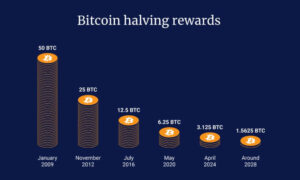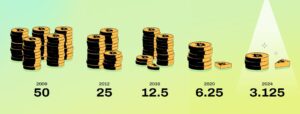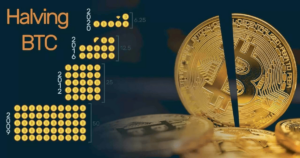In the world of cryptocurrency, Bitcoin halving is a special event that attracts significant attention from investors and financial experts alike. Seen as a key factor influencing the supply and value of Bitcoin, halving is not only a technical term but also a strategic indicator for those wishing to participate in this market. So, what exactly is Bitcoin halving, and why is it important for investors? This article will provide an overview of this event and essential information for investing in Bitcoin halving.
1. What is Bitcoin Halving?
Bitcoin halving is a significant event in the Bitcoin ecosystem that occurs every time the block reward given to Bitcoin miners is halved. Each time a Bitcoin halving event takes place, the number of new Bitcoins generated and distributed to miners for successfully mining a block is reduced by 50%, directly impacting the supply and demand dynamics and the value of the cryptocurrency.
Since Bitcoin’s inception in 2009, the block reward was set at 50 BTC per mined block. However, the first halving event took place in 2012, reducing the reward to 25 BTC per block. In 2016, the second halving event took place, further reducing the reward to 12.5 BTC. The most recent halving, in 2020, reduced the reward to 6.25 BTC per block.
Designed as a mechanism to control Bitcoin’s supply over time, Bitcoin halving helps maintain the finite supply of the cryptocurrency. This also creates an incentive mechanism to combat inflation. As the mining reward decreases, mining becomes more challenging, requiring more resources and effort to obtain the same amount of Bitcoin. This scarcity can increase the value of Bitcoin, while also having a significant impact on the market.
With a large impact on both the technical and economic aspects of the Bitcoin network, Bitcoin halving is always a key event closely followed by the cryptocurrency community. It not only drives the development and stability of the network but also serves as an important indicator for investors and miners in adjusting their strategies.
2. Key Insights for Investing in Bitcoin Halving
2.1. The Significance of Halving Events for Bitcoin
Bitcoin halving events are critically important for the Bitcoin network because they do not just limit the creation of new Bitcoin but also make the process of mining Bitcoin progressively more difficult over time. After each halving event, the block reward for miners is cut in half, reducing the total amount of new Bitcoin created and ultimately capping the total supply at 21 million Bitcoin.

This supply limitation acts as a stimulus, potentially creating upward pressure on Bitcoin’s value. As the mining reward decreases, the amount of new Bitcoin produced diminishes, while demand remains constant or even increases, which could drive the price of Bitcoin higher. However, Bitcoin’s value is not solely dictated by halving events; it is also influenced by a range of other factors, including market interest, the adoption and practical use of Bitcoin in the real world, and broader economic and financial factors.
Therefore, while Bitcoin halving is an important technical event, its effect on the value of Bitcoin is also shaped by many other economic and social factors.
2.2. How Will Miners Be Affected by Bitcoin Halving?
Bitcoin halving has a profound impact on miners, particularly in terms of economics and technical challenges. When the block reward is halved, Bitcoin mining becomes more difficult, requiring miners to use more resources and effort to obtain the same amount of Bitcoin as they did before the halving event.
This can create significant turbulence in the mining community, especially for smaller miners with less powerful equipment and technology. These miners may struggle to maintain profitability as the block reward decreases and mining costs increase. As a result, many smaller miners may find it difficult to compete with larger mining operations and may be forced to exit the market. This could lead to a reduction in the number of miners participating in the network, potentially affecting the distribution and security of the Bitcoin network.
However, for large-scale miners with advanced equipment, a block reward reduction can still be profitable if the price of Bitcoin increases, compensating for the higher mining costs.
2.3. How does Halving affect Bitcoin’s price?
Impact on Investors
For investors, Bitcoin halving means a reduction in the frequency of new Bitcoin being created, which in turn decreases the selling pressure from miners. History has shown that the increasing scarcity of Bitcoin after each halving typically boosts positive sentiment in the investment community. With the halving event reducing the block reward, the supply of new Bitcoin will be limited, leading many investors to expect a price increase for this cryptocurrency.
Past halving events have had a positive impact on Bitcoin’s price. Specifically, during the 2020 halving event, Bitcoin’s price increased by about 40% afterward, driven by investor participation and expectations of price appreciation. Similarly, ahead of the upcoming halving event, Bitcoin’s price has shown a strong upward trend, reaching around $65,000, approaching its all-time high.

Impact on Miners
For Bitcoin miners, the halving event has a very different significance. The block reward will be cut in half, which immediately reduces their revenue. Mining Bitcoin is already an expensive endeavor, requiring significant investments in equipment, electricity costs, and operational expenses for mining facilities. Miners typically rely on the price of Bitcoin to rise in order to offset these costs and maintain profitability. However, after each halving event, as the block reward decreases, many smaller miners will face a challenging situation where mining costs may exceed the profits they earn.
If Bitcoin’s price does not rise sufficiently to cover mining expenses, some miners may be forced to shut down their operations. This could lead to a decrease in the network’s hash rate (mining speed), slowing down transaction verification on the blockchain. However, if Bitcoin’s price continues to rise significantly, miners will have the incentive to restart their mining operations, keeping the hash rate stable and ensuring the smooth operation of the Bitcoin network.
2.4. How Does Bitcoin Halving Work?
Bitcoin Mining Process
Bitcoin miners compete to add new blocks to the blockchain, which is where all Bitcoin transactions are stored. Each block contains information about Bitcoin transactions and has a size of approximately 1 megabyte (MB). To add a block to the blockchain, miners must solve a complex cryptographic puzzle using specialized hardware, generating a random 64-character string known as a “hash.” This process requires substantial computational power and demands that miners use powerful equipment to ensure the block is added to the network correctly.
When a miner successfully solves the puzzle and adds a block to the blockchain, they are rewarded with a certain number of Bitcoin. Initially, this reward was 50 BTC per block mined. However, to control supply and reduce inflation, the reward for miners is halved every 210,000 blocks, or roughly every four years. This is the Bitcoin halving mechanism.
Halving Mechanism and Its Impact on Bitcoin Supply
With each halving event, the reward for mining a Bitcoin block is cut in half. For example, after the first halving in 2012, the reward was reduced from 50 BTC to 25 BTC. The second halving in 2016 cut the reward to 12.5 BTC, and after the third halving in 2020, the reward dropped to 6.25 BTC. Each halving event reduces the number of new Bitcoins released into the market, helping to control the growth rate of the Bitcoin supply.
This halving mechanism is designed to ensure that the total supply of Bitcoin will never exceed 21 million BTC. As the rewards decrease, mining becomes more difficult, and only those miners with sufficient resources and technology will be able to maintain profitability. The halving also creates scarcity, which could potentially increase the value of Bitcoin if demand remains stable or increases.
2.5. The downside of Halving
Negative Environmental Impact
Bitcoin has long been criticized for the massive energy consumption associated with mining operations. Each time a halving event occurs, the difficulty of mining Bitcoin increases, forcing miners to use more powerful hardware to solve complex puzzles and validate transactions. This results in an even higher energy consumption, particularly as mining machines must run continuously at high power to maintain performance.
To mitigate costs and avoid diminishing returns, miners are forced to upgrade their equipment, improve energy efficiency, and seek more sustainable energy sources, such as solar power. However, even with a shift toward renewable energy, the environmental impact of Bitcoin mining remains a significant issue that requires attention and resolution.

Risk of Network Centralization
One of the key principles behind Bitcoin’s design is its decentralization, intended to prevent control by any single individual or organization. However, as mining rewards decrease after each halving event, competition in the mining industry becomes more intense. Smaller miners who cannot afford to maintain large-scale mining operations are gradually pushed out, leading to a concentration of computational power (hashrate) in the hands of large mining organizations.
This concentration could result in the risk of network control by a small group of miners, enabling them to influence the transaction verification process. If a few miners control the majority of the computational power, they could potentially refuse to validate certain transactions, undermining Bitcoin’s decentralization and censorship resistance—principles that Satoshi Nakamoto envisioned when creating the cryptocurrency.
Data from BTC.com shows that between 2016 and 2021, two major mining groups, Foundry USA and AntPool, controlled between 30% and 40% of the network’s total hashrate. According to CoinDance, this number reached nearly 50% during peak periods.
Miners’ Actions After Halving
While halving presents significant challenges for miners, it does not mean they will abandon the network. Rather than quitting, many miners will seek ways to overcome the difficulties, optimize their mining operations, and adjust their strategies to maintain profitability. Smaller miners might join larger mining “pools” to share resources and minimize financial risks. Large-scale miners, with strong financial backing, will continue to lead the industry by improving mining efficiency and seeking cheaper and more sustainable energy sources.
To effectively invest in Bitcoin during a halving period, it is essential to be well-prepared, understand the event thoroughly, and closely monitor market conditions. Only with solid knowledge and a well-thought-out investment strategy can you fully capitalize on the opportunities that Bitcoin halving presents.














